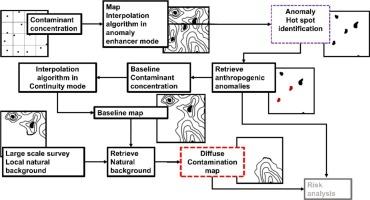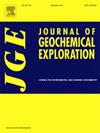改进空间插值的异常分析存在稀疏,聚类或不精确的数据集
IF 3.3
2区 地球科学
Q1 GEOCHEMISTRY & GEOPHYSICS
引用次数: 0
摘要
在本研究中,我们提出了一种专门针对稀疏、聚类或不精确环境数据(SIC)的插值和异常检测新方法。目前最先进的空间方法和模型无法处理这些数据,包括最广泛使用的空间方法和模型,如克里格。事实上,在SIC数据上获得的统计数据(在5-30的数量级上)不允许我们定义协方差或校准复杂贝叶斯或深度图像先验模型的众多超参数。因此,我们采用了一种信息传播算法来处理SIC数据。这种概率模型已经被丰富(各向异性、去聚类、自动变异、多支持、协变量处理和审查数据),以一种完全满足环境SIC数据需求的方式,可以与认知和任意不确定性的混合传播以及异常检测结合使用,无论其数学形式如何。本文将新的异常检测插值器应用于小尺度环境研究的13个稀疏数据点、数字挑战数据集和两个真实数据集,即大尺度地球化学数据集和SIC城市土壤数据集。结果突出了所提出算法的附加价值,即能够精确定位SIC数据中的异常,同时特别避免了某些先前方法的平滑效果。本文章由计算机程序翻译,如有差异,请以英文原文为准。

Improving spatial interpolation for anomaly analysis in presence of sparse, clustered or imprecise data sets
In this study, we present a new method of interpolation and anomaly detection especially designed for sparse, clustered or imprecise environmental data (SIC). Such data cannot be processed by current state of the art spatial methods and models, including the most widely used, such as kriging. Indeed, the statistics obtained on SIC data (on the order of 5–30) do not allow us to define a covariance or to calibrate the numerous hyper-parameters of sophisticated Bayesian or deep image prior models. We therefore adapted an information dissemination algorithm to handle SIC data. This probabilistic model has been enriched (anisotropy, de-clustering, auto-variography, multi-support, treatment of covariates, and censored data) in a way that fully meets the needs for environmental SIC data and can be used in conjunction with hybrid propagation of epistemic and aleatoric uncertainties and anomaly detection, whatever their mathematical form. The new interpolator for anomaly detection was applied on a very small set of 13 sparse data points characteristic of small-scale environmental studies, on digital-challenge datasets and on two real datasets, i.e., a large-scale geochemical dataset and a SIC urban soil dataset. Results highlight the added value of the proposed algorithm, that is able to pinpoint anomalies in SIC data, while avoiding in particular the smoothing effects of certain previous methods.
求助全文
通过发布文献求助,成功后即可免费获取论文全文。
去求助
来源期刊

Journal of Geochemical Exploration
地学-地球化学与地球物理
CiteScore
7.40
自引率
7.70%
发文量
148
审稿时长
8.1 months
期刊介绍:
Journal of Geochemical Exploration is mostly dedicated to publication of original studies in exploration and environmental geochemistry and related topics.
Contributions considered of prevalent interest for the journal include researches based on the application of innovative methods to:
define the genesis and the evolution of mineral deposits including transfer of elements in large-scale mineralized areas.
analyze complex systems at the boundaries between bio-geochemistry, metal transport and mineral accumulation.
evaluate effects of historical mining activities on the surface environment.
trace pollutant sources and define their fate and transport models in the near-surface and surface environments involving solid, fluid and aerial matrices.
assess and quantify natural and technogenic radioactivity in the environment.
determine geochemical anomalies and set baseline reference values using compositional data analysis, multivariate statistics and geo-spatial analysis.
assess the impacts of anthropogenic contamination on ecosystems and human health at local and regional scale to prioritize and classify risks through deterministic and stochastic approaches.
Papers dedicated to the presentation of newly developed methods in analytical geochemistry to be applied in the field or in laboratory are also within the topics of interest for the journal.
 求助内容:
求助内容: 应助结果提醒方式:
应助结果提醒方式:


